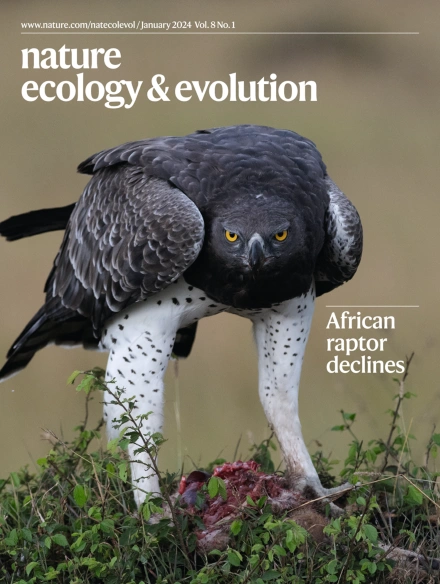Mitochondrial genomes of Middle Pleistocene horses from the open-air site complex of Schöningen.
IF 13.9
1区 生物学
Q1 ECOLOGY
引用次数: 0
Abstract
Deep-time palaeogenomics offers rare insights into macroevolutionary events for both extant and extinct species. Aside from a Middle Pleistocene genome from North American permafrost (780-560 ka) and a number of Late Pleistocene specimens, most ancient horse DNA studies have focused on tracing the origins of domestication and subsequent periods. Here we present mitochondrial genomes from two Equus mosbachensis specimens from Schöningen, Germany, a Middle Pleistocene archaeological site complex with direct and repeated evidence of hominin-horse interactions on the shore of a palaeolake. Using petrous bone sampling, targeted enrichment and damage-aware and polarization-free mitochondrial DNA reconstruction methods, we extend the range of genome recovery in open-air sites to ~300,000 years ago. Phylogenetic analyses position these mitochondrial DNAs in two distinct, deeply divergent lineages, basal to both previously sequenced ancient Eurasian specimens and all modern-day horses. The Schöningen horse mitochondrial DNA data reveal a previously unrecognized diversification event within the clade, ultimately giving rise to modern-day horses, that is molecularly dated to ~570 ka and provides genetic support for the morphological species assignment. By extending the recoverable limits of ancient DNA from Middle Pleistocene open-air sites, our molecular findings bridge a temporal and geographic gap, providing insights on early evolutionary events within the genus Equus.来自Schöningen露天遗址复合体的中更新世马的线粒体基因组。
深时间古基因组学为现存和灭绝物种的宏观进化事件提供了罕见的见解。除了来自北美永久冻土(780-560 ka)的中更新世基因组和一些晚更新世标本外,大多数古马DNA研究都集中在追踪驯化的起源和随后的时期。在这里,我们展示了来自德国Schöningen的两个马科动物标本的线粒体基因组,这是一个中更新世考古遗址群,在古湖岸边有人类与马相互作用的直接和反复的证据。利用岩骨取样、靶向富集、损伤感知和无极化线粒体DNA重建方法,我们将露天遗址的基因组恢复范围扩展到30万年前。系统发育分析将这些线粒体dna定位在两个截然不同的、深度分化的谱系中,它们是先前测序的古代欧亚标本和所有现代马的基础。Schöningen马的线粒体DNA数据揭示了进化分支中一个以前未被认识到的多样化事件,最终产生了现代马,这一分子可追溯到~570 ka,并为形态物种分配提供了遗传支持。通过扩大中更新世露天遗址古代DNA的可恢复范围,我们的分子发现弥合了时间和地理上的差距,为马属的早期进化事件提供了见解。
本文章由计算机程序翻译,如有差异,请以英文原文为准。
求助全文
约1分钟内获得全文
求助全文
来源期刊

Nature ecology & evolution
Agricultural and Biological Sciences-Ecology, Evolution, Behavior and Systematics
CiteScore
22.20
自引率
2.40%
发文量
282
期刊介绍:
Nature Ecology & Evolution is interested in the full spectrum of ecological and evolutionary biology, encompassing approaches at the molecular, organismal, population, community and ecosystem levels, as well as relevant parts of the social sciences. Nature Ecology & Evolution provides a place where all researchers and policymakers interested in all aspects of life's diversity can come together to learn about the most accomplished and significant advances in the field and to discuss topical issues. An online-only monthly journal, our broad scope ensures that the research published reaches the widest possible audience of scientists.
 求助内容:
求助内容: 应助结果提醒方式:
应助结果提醒方式:


